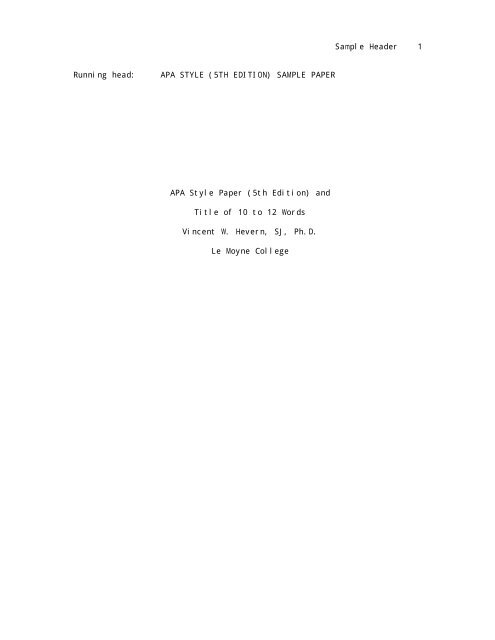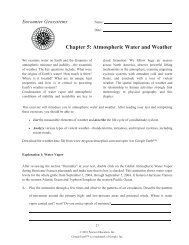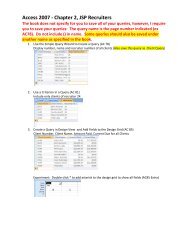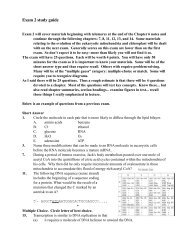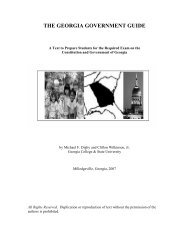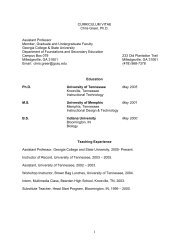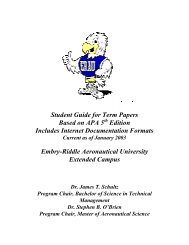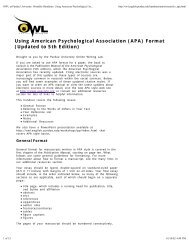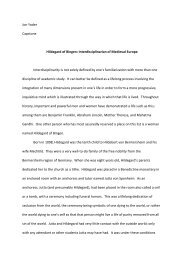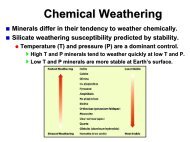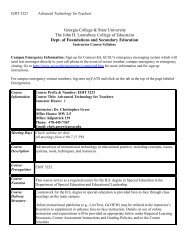Sample Header 1 Running head: APA STYLE (5TH EDITION ...
Sample Header 1 Running head: APA STYLE (5TH EDITION ...
Sample Header 1 Running head: APA STYLE (5TH EDITION ...
You also want an ePaper? Increase the reach of your titles
YUMPU automatically turns print PDFs into web optimized ePapers that Google loves.
<strong>Sample</strong> <strong>Header</strong> 1<br />
<strong>Running</strong> <strong>head</strong>:<br />
<strong>APA</strong> <strong>STYLE</strong> (<strong>5TH</strong> <strong>EDITION</strong>) SAMPLE PAPER<br />
<strong>APA</strong> Style Paper (5th Edition) and<br />
Title of 10 to 12 Words<br />
Vincent W. Hevern, SJ, Ph.D.<br />
Le Moyne College
<strong>Sample</strong> <strong>Header</strong> 2<br />
Abstract<br />
The abstract is a summary of the contents of the paper. It begins on a<br />
new page. It should be a single paragraph (not indented and NOT<br />
justified) of no more than 960 characters, including punctuation and<br />
spaces. Reviews or theoretical articles should use 75 to 100 words and<br />
empirical studies should use 100 to 120 words. All numbers, except those<br />
beginning sentences, are typed as digits. The abstract is accurate,<br />
concise and specific, without abbreviations or acronyms, and<br />
nonevaluative. The abstract summarizes the methods(s) of study,<br />
hypothesis(es), and any empirical results. Conclusions and implications<br />
usually end the abstract.
<strong>Sample</strong> <strong>Header</strong> 3<br />
<strong>APA</strong> Style Paper (5th Edition) and<br />
Title of 10 to 12 Words<br />
Manuscripts presented by psychologists for publication generally<br />
follow the guidelines explained in the current Publication Manual of the<br />
American Psychological Association (<strong>APA</strong>, 2001) which is now in its 5th<br />
edition. These guidelines have historically been given the general name<br />
of "<strong>APA</strong> Style" and differ in very important ways from the style and<br />
formats used by other disciplines, e.g., the Modern Language Association<br />
(MLA) style or the widespread University of Chicago Press style<br />
(Turabian, 1973). This paper will explain the major elements of <strong>APA</strong><br />
style and is itself presented in this style to show you what a sample<br />
manuscript should look like. The widespread introduction of personal<br />
computers and the Internet over the last decade has resulted in many<br />
changes in <strong>APA</strong> style which are reflected in this paper.<br />
<strong>APA</strong> Style is fairly straight forward in its approach. It<br />
presupposes that the text of the paper or article you have written will<br />
follow a structure of some type. All papers begin with an Introduction<br />
although you should never use the word "Introduction" as a <strong>head</strong>ing or<br />
label. This introductory section should introduce the problem, develop<br />
the background to your study, and then state the purpose and rationale<br />
for the remainder of your report or research (<strong>APA</strong>, 2001, pp. 15-17).<br />
The structure of theoretical, review, and historical papers will<br />
depend upon what you are writing about. Compared to empirical or<br />
experimental papers (see below), there is no automatic set of sections<br />
which are used in a theoretical, review, or historical paper. However,<br />
as an aid to your thinking, consider the structure of an imaginary
<strong>Sample</strong> <strong>Header</strong> 4<br />
literature review paper that focuses upon "Treatment Approaches to<br />
Alcoholism." Topics here flow in a logical order and there is an<br />
overarching structure to the paper. Evaluations or presentations of your<br />
opinion(s) are normally reserved for the ending Discussion section of a<br />
paper. Table 1 displays what the structure of a hypothetical literature<br />
review might look like.<br />
In papers which are experimental or empirically-based, the<br />
introductory section is followed by three sections which are labeled:<br />
Method, Results, and Discussion. The Methods section contains a<br />
description of what was done by you as a researcher. It may have<br />
subsections labeled, e.g., participants, the apparatus, the procedure<br />
and so on. The Results section provides an overview of the data gathered<br />
and any statistical analyses of these data. Finally, the Discussion<br />
section follows. Only after you have presented all the objective data in<br />
the past sections should you offer any evaluation or interpretation of<br />
these data in the Discussion section. In this section you should cite<br />
how your results compared with predictions of your original<br />
hypothesis(es) and suggest directions for future research.<br />
Note that psychologists do not cite page numbers in the references<br />
unless a direct quotation is made or attention is being directed to a<br />
particular citation in the literature. It is usual practice to give only<br />
a general reference and allow the readers to consult the references<br />
themselves if they need to examine the item or study more thoroughly.<br />
Psychologists do not provide bibliographies in their papers; these are<br />
called References and only contain materials actually used in the paper<br />
(see the Reference section at the end of this paper). This list of
<strong>Sample</strong> <strong>Header</strong> 5<br />
sources is never called "Bibliography" or some such title. Psychologists<br />
do not use footnotes except in very rare circumstances. In order to<br />
indicate how references are written, I will make note of several<br />
different types here and direct you to look at how they are formatted in<br />
the accompanying References section: a journal article (Bekerian, 1993),<br />
a book (Cone & Foster, 1993; Mitchell & Larson, 1987), an edited book<br />
(Gibbs & Huang, 1991), and a book chapter in an edited book (Bjork,<br />
1989). A newspaper article ("New drug," 1993) or a magazine article<br />
(Posner, 1993) might be cited by a writer. Check the Publication Manual<br />
(<strong>APA</strong>, 2001) to examine the 70 separate types of citations that can be<br />
made. The 5th edition of the Manual contains detailed examples of how to<br />
specify legal references as well as how to cite electronic, computerbased<br />
or Internet-derived sources. I have included in the accompanying<br />
Table 2 some examples of what such references look like for several<br />
types of materials.
<strong>Sample</strong> <strong>Header</strong> 6<br />
References<br />
American Psychological Association. (1991). Publication manual of the<br />
American Psychological Association (5th ed.). Washington, DC: Author.<br />
Bekerian, D. A. (1993). In search of the typical eyewitness. American<br />
Psychologist, 48, 574-576.<br />
Bjork, R. A. (1989). Retrieval inhibition as an adaptive mechanism in<br />
human memory. In H. L. Roediger III & F. I. M. Craik (Eds.),<br />
Varieties of memory & consciousness (pp. 309-330). Hillsdale, NJ:<br />
Erlbaum.<br />
Cone, J. D., & Foster, S. L. (1993). Dissertations and theses from start<br />
to finish: Psychology and related fields. Washington, DC: American<br />
Psychological Association.<br />
Gibbs, J. T., & Huang, L. N. (Eds.). (1991). Children of color:<br />
Psychological interventions with minority youth. San Francisco:<br />
Jossey-Bass.<br />
Mitchell, T. R., & Larson, J. R., Jr. (1987). People in organizations:<br />
An introduction to organizational behavior (3rd ed.). New York:<br />
McGraw-Hill.<br />
New drug appears to sharply cut risk of death from heart failure. (1993,<br />
July 15). The Washington Post, p. A12.<br />
Posner, M. I. (1993, October 29). Seeing the mind. Science, 262, 673-<br />
674.<br />
Turabian, K. L. (1973). A manual for writers of term papers, theses, and<br />
dissertations (4th ed.). Chicago: University of Chicago Press.
<strong>Sample</strong> <strong>Header</strong> 7<br />
Table 1<br />
Possible Structure for a Literature Review of "Treatment Approaches to<br />
Alcoholism"<br />
________________________________________________________________________<br />
(Introduction) [This is not written in the text of the paper]<br />
Historical Approaches<br />
A. Moral Treatments<br />
B. Legal Penalties<br />
C. Other Failed Methods<br />
Alcoholics Anonymous: The First 12–Step Method<br />
Current Medical Approaches<br />
A. Treatment of Withdrawal<br />
B. Treatment of Underlying Alcoholism<br />
Hospitalization.<br />
Antabuse and Other Pharmacological Treatments.<br />
Group and Rehabilitative Therapies.<br />
C. The Problem of Controlled Drinking<br />
Discussion of Future Directions in Treatment<br />
________________________________________________________________________
<strong>Sample</strong> <strong>Header</strong> 8<br />
Table 2<br />
Examples Citation Formats for Selected Types of Electronic and Internetbased<br />
Sources<br />
______________________________________________________________<br />
Internet article based on a print source<br />
Sternberg, R. J., & Grigorenko, E. L. (2001). Unified psychology<br />
[Electronic version]. American Psychologist, 56, 1069-1079.<br />
If you think the article may have been changed when put online, you<br />
should use this version:<br />
Sternberg, R. J., & Grigorenko, E. L. (2001). Unified psychology.<br />
American Psychologist, 56, 1069-1079. Retrieved March 6, 2002 from<br />
PsycARTICLES database: http://gateway1.ovid.com:80/ovidweb.cgi<br />
Article from Internet-only journal<br />
Massey, A. & Hevern, V. W. (1996, December/1997, April). Postscript<br />
two: Literature as geodetic survey map. The Qualitative Report,<br />
2(4). Retrieved April 14, 2002 from<br />
http://www.nova.edu/ssss/QR/QR2-4/massey3.htm<br />
Multipage document, no date<br />
University of Kent at Canterbury, The Centre for Social Anthropology<br />
and Computing. (n.d.). 45 years in the Turkish village, 1949-1994.<br />
Paul Stirling's ethnographic data archives. Retrieved April 14,<br />
2002 from http://lucy.ukc.ac.uk/TVillage/notes.html
<strong>Sample</strong> <strong>Header</strong> 9<br />
Paper presented at a Conference, abstract retrieved from<br />
University web site.<br />
Hevern, V. W. (2000, June). Alterity and self-presentation via the<br />
Web: Dialogical and narrative aspects of identity construction.<br />
Paper presented at the 1 st International Conference on the<br />
Dialogical Self. Abstract retrieved April 14, 2002 from<br />
http://www.socsci.kun.nl/psy/congress2000/papers/hevern.htm


